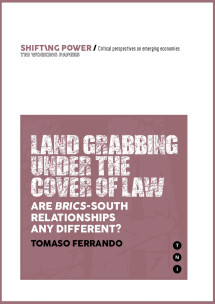Ideas into movement
Boost TNI's work
50 years. Hundreds of social struggles. Countless ideas turned into movement.
Support us as we celebrate our 50th anniversary in 2024.

The BRICS are following the pattern traditionally adopted by Northern countries of enclosing and exploiting land, both nationally and abroad, to benefit capital and global agro-industrialisation. They are also using law and diplomacy, notably Bilateral Investment Agreements, in order to facilitate access to foreign land, and foster their own economic interests.

Transnational Institute’s (TNI) Shifting Power Working Paper Series seeks to help movements navigate our changing multipolar world as well as provide an invaluable source of alternative analysis for students, analysts and journalists.
Land grabbing under the cover of law: Challenges and Opportunities for South Africa and Africa
There is a general consensus among academics, politicians and social movements, that BRICS as ‘new donors’ are increasing both their quantitative and qualitative role in defining what is considered to be ‘the world economic order’.
In particular, several authors have underlined the importance of BRICS as a challenge to the traditional development paradigm, describing the five countries as proponents of a South-South cooperation which weakens the so-called Washington Consensus because it does not attach policy conditionalities, provides assistance based on a win-win paradigm, and places emphasis on how to ensure economic sustainability of the recipient country.
Moreover, such rhetoric is not only produced by academics or international financial institutions, but fostered and reinforced by BRICS themselves. For example, while China especially stresses the need to respect the sovereignty of the receiving country, all the BRICS are trying to create an identity which differs from that of established donors, and claim to promote alternative strategies based on equality, solidarity, mutual development and cooperation.
These differences from traditional Northern donors, it is assumed, contribute to more effective cooperation and to a better reception by local populations.
This chapter does not challenge the idea that some differences exist between the way in which Northern donors and BRICS conceive receiving countries’ sovereignty and their independence where official development assistance (ODA) is at stake. Rather, it focuses on large-scale investments in foreign land (LaSIL) and concludes that, when access to this scarce resource is at stake, the legal mechanisms, rhetorical approaches and geostrategic positions of the BRICS (with the exception of Russia) toward the South replicate the traditional strategy of Northern countries more than the general narrative about emerging donors may suggest.
Leaving aside the political, economic and social importance that the large-scale industrialisation of agriculture plays in transforming each of the BRICS, this chapter focuses exclusively on the ‘global land rush’, that is, the attempt to control and exploit land abroad.
---
Tomaso Ferrando is a PhD Student at the Sciences Po Law School and Visiting Researcher at the USP Commercial Law Department, São Paulo and at the UCT Public Law Department, Cape Town. This paper was first presented at the Oxford-Sciences Po (OXPO) Doctoral Seminar, Oxford University, May 18th 2012.